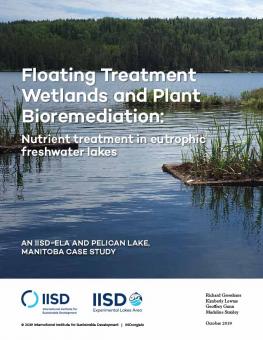
Floating Treatment Wetlands and Plant Bioremediation: Nutrient treatment in eutrophic freshwater lakes
Allow us to explain why floating treatment wetlands are an innovative “natural infrastructure" option for effective biological treatment and removal of nutrients to help clean up algal blooms in surface waters.
-
This study examines the use of floating treatment wetlands (FTWs) as an innovative bioremediation option for smaller bodies of water that suffer from algal blooms.
-
FTWs are a proven concept and have been successfully deployed around the world for the treatment of surface water and stormwater runoff, municipal wastewater effluent, landfill leachate and mine site tailings ponds.
-
Our research at IISD Experimental Lakes Area showed that a relatively small increase in phosphorus resulted in a rapid increase in plant productivity on floating platforms, suggesting that FTWs can be an effective bioremediation option for Manitoba.
Key Messages
- This study examines the use of floating treatment wetlands (FTWs) as an innovative bioremediation option for smaller bodies of water that suffer from algal blooms.
- FTWs are a proven concept and have been successfully deployed around the world for the treatment of surface water and stormwater runoff, municipal wastewater effluent, landfill leachate and mine site tailings ponds.
- Our research at IISD Experimental Lakes Area showed that a relatively small increase in phosphorus resulted in a rapid increase in plant productivity on floating platforms, suggesting that FTWs can be an effective bioremediation option for Manitoba.
Wetlands and their aquatic plant communities play an important role in improving water quality. The use of wetlands, both natural or constructed, is widely practiced around the world for bioremediation treatment of stormwater runoff, municipal wastewater effluent, landfill leachate and mine tailings.
FTWs allow water treatment in water bodies that are too deep for plants to grow and under fluctuating water levels. Plants take up nutrients and contaminants themselves, but research suggests the majority of nutrient uptake and degradation is by the biofilm—the algae, bacteria and other microbes that coat the extensive surface area of plant roots and island surface.
Floating wetland platforms were deployed in two lakes of different phosphorus concentrations at IISD Experimental Lakes Area (IISD-ELA).This study demonstrated that FTWs are an effective passive biological bioremediation option to help remediate eutrophication in surface waters. FTWs offer an innovative “natural infrastructure” alternative to conventional in-lake remediation strategies.
Ultimately, FTWs deployed in combination with other in-lake remediation treatments and watershed nutrient reduction strategies, targeting both internal and external nutrient loading sources, would be most effective and provide additional positive contributions to the health of the aquatic environment.
Participating experts
You might also be interested in
The Chemical Analysis of Fresh Water (Third Edition)
This publication describes the protocols used in the IISD Experimental Lakes Area Analytical Service Laboratory for the measurement of chemical constituents in freshwater samples.
IISD Annual Report 2023–2024
While IISD's reputation as a convenor, a trusted thought leader, and a go-to source on key issues within the sustainable development field is stronger than ever, the work happening outside the spotlight is just as valuable.
Building Natural Infrastructure Capacity Across Professions and Skilled Trades in the Canadian Prairies
As the demand for natural infrastructure continues to grow across the Canadian Prairies, it's essential to build more professional capacity in the skilled trades.
For Nature-Based Solutions to Be Effective, We Need to Work with Indigenous Peoples and Local Communities
Nature-based solutions have been praised as a promising approach to tackling the twin crises of climate change and biodiversity loss. But some Indigenous Peoples and local communities are questioning the legitimacy of the concept and what it symbolizes. It is time to listen to what they have to say.